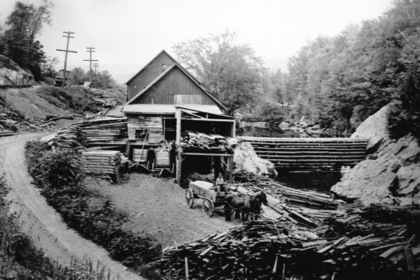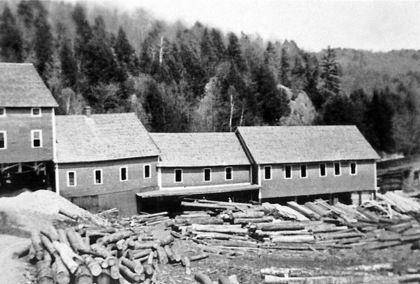
Ward's Upper Mill was located just below the bridge at the
south end of Moretown. Photo courtesy of Mary Gow
The Moretown Historical Society invites the public to a potluck lunch at the Moretown Town Hall on Sunday, May 20, at 12:30. There is no charge. Bring a dish to share; plates and utensils provided. This lunch kicks off Moretown’s preparations for the next year’s celebration of the 250th anniversary of its charter, granted by Benning Wentworth, Royal Governor of New Hampshire, on June 7, 1763.
During Sunday’s event, the Ward Clapboard Mill will be open and in operation. The mill, in the building adjacent to the Town Hall, produces high-quality vertical-cut clapboards. Some of the mill’s equipment dates from the late 1800s and has been in use since the early days of the Ward family’s lumber business.
From the late 1800s until it moved its main operations to Waterbury in 1962, Ward Lumber Company was Moretown’s largest employer. Many Valley families had ties to Ward Lumber. For many years, 40 to 50 men regularly worked in the Moretown mills, running the saws, edgers, and planers and sticking lumber in the yards. Local loggers sold timber to the Ward mills or worked directly for the company, harvesting trees from Ward forestland. Many longtime community members still recall the vast lumber yards in Moretown and the Upper and Lower Mills that book-ended the village.
The Ward lumber business started shortly after the Civil War. Hiram (H.O.) Ward, a young Duxbury native who studied at the Eastman School of Business in Poughkeepsie, New York, bought a small mill on the upper reaches of Dowsville Brook in 1872. While continuing to farm, Ward expanded his lumber operations to include several sawmills. Moretown, at the time, as the 1882 Vermont Historical Gazetteer noted, was interested in attracting more business:
“The Mad River affords some of the best water privileges found in the State, and should the inhabitants of Moretown induce some moneyed firm to put in a large manufacturing house here, thus utilizing more of the water power, and urge the building of a contemplated railroad, which has already been surveyed through the town, it would greatly develop the resources of and build up our town.” (p. 597)
Although the railroad never came to Moretown, Hiram Ward did. In 1890, he moved his business there and, in short order, had two very productive mills running at full speed – the Upper Mill located just below the bridge at the south end of town and the Lower Mill just below the site of the present Ward Clapboard Mill. In the 1890s, Ward Lumber frequently shipped 19 boxcars of lumber per month by rail from Middlesex. Ward invested in equipment for the mills, traveled frequently to Massachusetts dealing lumber, and even had a telephone installed in his office in 1894 – an addition noteworthy enough to be mentioned in the newspaper.

The Lower Mill pre 1938. Photo courtesy of Mary Gow.
To ensure an adequate supply of logs for the mills, Hiram Ward acquired large tracts of forestland almost from the beginning. In the early 20th century, Hiram and his son Burton Ward, reportedly after hearing forester Gifford Pinchot, began establishing tree plantations. In that era of farm abandonment, they purchased farms that had gone out of production and planted the former fields with white pine and spruce. From around 1915 into the 1950s, planting and pruning Ward plantations was an annual event.
The Ward Lumber Company and the men and women who worked there produced a remarkable quantity and diversity of products. Lumber from trees that grew in central Vermont went to all corners of the country and beyond. Rocking chairs, parlor organs, pianos, thousands of cribs and playpens were among the household furnishings made from the company’s lumber. Trains rolled over Ward Lumber railroad ties. Giant hemlocks cut from Ward land in Warren helped build the St. Lawrence Seaway. Dimension lumber milled by the company went into countless buildings – from Massachusetts homes and tenements of the 1890s to 1950s housing developments in Burlington.
Ward Lumber Company moved its main operations from Moretown village to a new location along the railroad in Waterbury in 1962. In 1968, the Waterbury plant and 29,000 acres of Ward land, including many parcels in the Mad River Valley, were sold to Laird Properties.
Owen Ward, now of Florida, recently commissioned a book to preserve the history of the Ward Lumber Company. Mary Gow, Warren, and Kitty Werner, Waitsfield, worked with the Ward family to develop the book, which was published earlier this year by Werner’s Distinction Press. Owen Ward, Werner and Gow will be on hand for book signing at the Moretown Historical Society luncheon on Sunday. Books will be available from and for the benefit of the Moretown Historical Society. For information call Denise Gabaree at 496-2090.
{loadnavigation}





